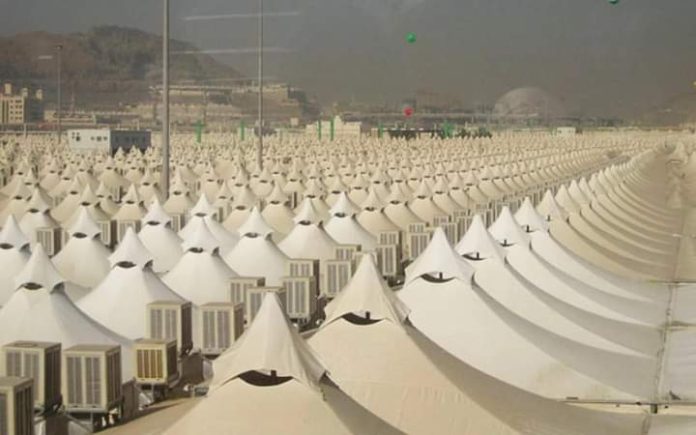
By Ibrahim Muhammed
The challenges of insufficient services experienced by virtually all hajj participating countries in Mina this year is not about “inadequate tents’, rather it is about space management to accommodate over 2.3 million pilgrims. Saudi Arabia can afford to construct 1 million tents to solve the yearly logjam in Mina but they will need more expanse to host the tent. The major challenges have been how to accommodate the maximum number of pilgrims in Mina tents while preserving the maximum level of comfort.
Although there are attempts to improve Mina’s capacity using new architectural designs to augment the number of pilgrims.
Every year and starting from the 8th of Dhul Hijja, Hajj pilgrims converged in Mina as part of the spiritual transit process to Arafat ground to observe the Day of Arafat. The name Mina is derived from the word with the root letters ma-na-ya, Mina means ‘to find’ or ‘to undergo test’ or ‘to be put to the test.’ Mina is connected to the words ‘tamannd’ and ‘manna’, which means ‘to hope for’ or ‘awaken a desire.’
The spiritually applicable meaning of Mina in itself indicates that it is not a place for “desirable comforts” but rather an area where our faith will be put to test in the quest of attaining Hajj mabrur.
The research was conducted in 2016 using Mina Tent Distribution Algorithm MTDA to better utilize the available capacity of Mina’s area in the best possible way with efficient use of the available resources. MTDA employs seven functions during the search process to find the best-fit accommodation for pilgrims in the available tents of Mina. Experimental results revealed that MTDA achieves better performance compared with eight algorithm schemes in all experimental cases. The best result of MTDA was obtained by allocating 80% of the total number of pilgrims over 76.2% of the total available accommodation space in the Mina area.
So, the best experimental result still did not project housing all the pilgrims in the tents
Mina covers an area of around 7.82 square kilometres. Out of which 4.8 square an equivalent of 61 per cent are utilised of the Valley’s area. The remaining are hilly areas utilised during Hajj. The size of Tents are either 8 square meters in size, 6 by 8 meters or 12 by 8 meters
In the last 15 years, the issue of how many numbers of pilgrims can be accommodated in Mina has been a recurrent pre-hajj topic among hajj-participating countries. Before the creation of additional driving and service lanes, the tents’ structure is designed to host around 850,000 pilgrims. Each pilgrim will be able to have a bed space inside a tent within the Mina boundary.
However, the creation of support facilities like Al Mashaaer Railway, Medical centres, security posts, muasasah office, ministry of hajj offices, Fire services offices emergency response centres takes about 20 percent of the initial projection when the first modern tents were built. In reality, Mina cannot comfortably host 800,000 pilgrims as it is.
Secondly, the introduction of mattresses in the tents compressed the space, unlike those years when pilgrims slept in plain rugs.
This year, there have been observations and complaints by virtually all the top ten hajj participating countries on the issue of providing enough space to host their respective numbers of pilgrims in Mina.
Anticipating a shortage of space, the Saudi Ministry of Hajj took a proactive step of directing pilgrims mostly from GCC countries constituting about 40 per cent of the total numbers of 2023 Hajj pilgrims to proceed from their hotels in Makkah to Arafat – skipping the first day in Mina.
So, the issue of having a comfortable space in Mina within the current global hajj allocation of about 2.3 million will remain a dilemma for Saudi Arabia’s Ministry of Hajj and Hajj participating countries
Most of the Major Car service lanes have been dualized taking a large chunk of the space initially designed for tents.
Pressure from Hajj participating countries requesting more slots and the Kingdom of Saudi Arabia’s plan to host 30 million pilgrims within the target scope of its Vision 2030 is making the issue of adequate bed space wishful thinking.
A member of the Indonesian House of Representatives Commission VIII, Endang Maria Astuti, while complaining about the inadequacy of the tents stated that “Indonesian hajj pilgrim tents in Mina were over capacity. In the field survey results at Indonesian Maktab Numbers 66, 67, and 68, out of a total of approximately 360 pilgrims per group, the tents were only able to accommodate around 260 hajj pilgrims.
“Meaning, there is a difference of 100 members of the congregation which makes the space unfit, resulting in them having to sleep cramped. Even some had to sleep sitting down because there was not enough space,”
Speaking further the Malaysian lawmakers said the Mashariq muasasah did not fulfil its commitment to some components of the masyair during their stay in Arafah, Muzdalifah, and Mina.
Secondly, there were delays in consumption during the stay in Mina for the hajj pilgrims. Many members of the pilgrimage have not received their meals when they needed them. Thirdly, the bathrooms in the Mina and Arafah tents are also far from sufficient for the number of hajj pilgrims. This has resulted in long queues for toilet usage, He said.
Also, Malaysian pilgrims expressed their disappointment over the lack of adequate space in Mina in this year’s hajj with many of the pilgrims blaming Tambug Hajji officials
Reacting to the challenge, TH group managing director and chief executive officer Syed Hamadah Syed Othman said the issue has been affecting Haj pilgrims from all countries for a long time and is not something new.
“Tabung Haji (TH) clarified that the issue of limited and crowded space in Mina does not only affect Malaysian pilgrims but those from other countries as well, especially when the Haj quota is full or following an increase in quota”.
Elaborating, he said the borders of Arafah and Mina had been established by law and remain unchanged despite the growing number of pilgrims each year.
“The size and space of tents in Mina are beyond TH control because the facilities in Arafah and Mina are provided by the Saudi authorities for all countries,”
Nigerian pilgrims are not left out of the discomforts in Mina. Unlike other countries who are waiting for post-mortem to proffer a solution, The Chairman of NAHCON and his management team acted in quick response mode when they rush to meet the Muasasah for African non-Arab and comes back with a promise of an additional 10,000 tent capacity – later provided and occupied by some Tour Operators pilgrims.
About the challenges faced by pilgrims this year, Minister of Hajj and Umrah Dr. Tawfiq Al-Rabiah while addressing the closing ceremony of an event in Makkah said that “there will be no allotment of specific areas for countries at the holy sites for the Hajj of 1445 AH (2024). “Priority will be given while allotting areas to those countries which finish the terms and conditions and provisions of bilateral agreements and completing all the preparations for the Hajj,”
The announcements if a tactical way of ‘attacking for defence’ to put all the hajj participating countries on their toes against next year’s hajj.
In 2014, a proposal was forwarded to the Haj Ministry to create a state-owned company to construct multi-story buildings on mountains in Mina to accommodate more pilgrims during Haj.
The then Minister of Hajj, Bandar Hajjar said the plan was rerouted to Interior Minister Prince Mohammed bin Naif who also doubles as Chairman of the Supreme Haj Committee on how to finance the projects. The constructions according to the plan, will follow the conditions set by the Council of Senior Islamic Scholars and the development plan for holy sites.
Mina is mentioned in Surah Al-Baqarah in the Holy Quran as follows: “And remember Allah during [specific] numbered days. Then whoever hastens [his departure] in two days – there is no sin upon him, and whoever delays [until the third] – there is no sin upon him – for him who fears Allah. And fear Allah and know that unto Him you will be gathered.” [Holy Quran, 2:203]. This verse makes Mina a compulsory holy site to stay during the hajj period.
Finally, the best approach to solve the issue could have been to reduce the number of hajj quotas to the exact number of mattress spaces in Mina. The Saudi Vision 2030, the carry-over pilgrims form Covid 19 periods, and the ever-growing quest for more slots by hajj participating countries makes this option conflictingly difficult.
Muhammed, the National Coordinator
Independent Hajj Reporters
Writes from Misfala Makkah, Saudi Arabia
+966547818968














